 |
| June 13, 2023 | Volume 19 Issue 22 |
Designfax weekly eMagazine
Archives
Partners
Manufacturing Center
Product Spotlight
Modern Applications News
Metalworking Ideas For
Today's Job Shops
Tooling and Production
Strategies for large
metalworking plants
3D printer integrates thermoplastics and carbon fiber for large hypersonic parts
Engineers at Northrop Grumman are accelerating the development of high-temperature materials with the creation of the Scalable Composite Robotic Additive Manufacturing Carbon/Carbon (SCRAM C/C) system to support emerging hypersonic and high-speed weapons.
SCRAM is an industrial, true 6-axis continuous fiber-reinforced 3D printer that enables the fabrication of large, freeform, integrated composite structures mixing thermoplastics and carbon fiber. According to the company, "These structures then undergo a proprietary manufacturing process and turned into C/C [Carbon/Carbon] to service the high-temperature materials community where complex, near-net shapes are required."
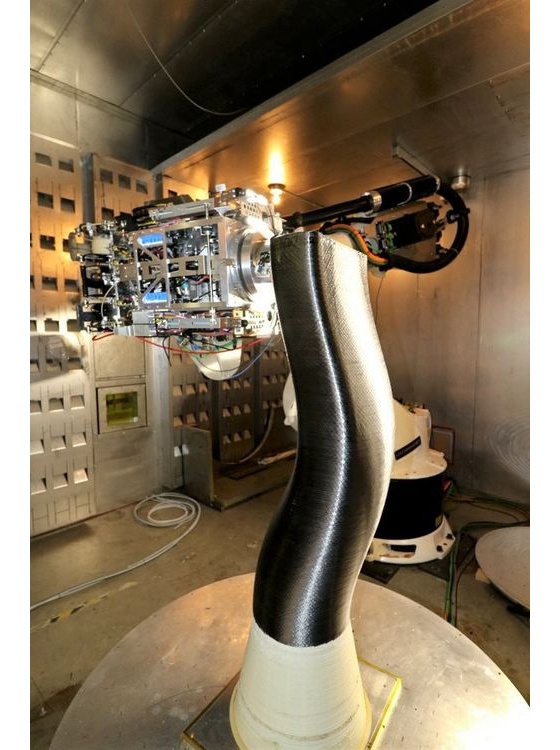
The SCRAM C/C system is shown printing a composite engine duct. [Credit: Northrop Grumman image].
"We are pioneering a rapid fabrication process that does not require tooling to manufacturing aerospace-grade, continuous fiber integrated composite structures," said Dan Olson, vice president and general manager of Weapon Systems for Northrop Grumman. "This manufacturing advancement will deliver capability to the field much faster than traditional methods, and ensures our warfighters have the latest technology and advanced weapons to counter both existing and future threats."
VIDEO: SEE HOW IT WORKS: Pioneering the Scalable Composite Robotic Additive Manufacturing Carbon/Carbon (SCRAM C/C) system. [Credit: Northrop Grumman]
Historically, Carbon/Carbon (C/C) manufacturing techniques have been labor intensive. By introducing process automation, the manufacturing time and cost can be reduced by up to 50% over traditional methods delivering capability to the field faster. Process automation has also shown a measurable uptick in component quality and consistency.
Northrop Grumman is printing continuous fiber composites at a large scale, an achievement that is unprecedented in the additive manufacturing industry. The company's process does not require long-lead tooling and incorporates in-situ consolidation of the composite, which dramatically changes the cost paradigm to manufacture high-temperature composites. The company has been awarded multiple patents on SCRAM technology.
"Hypersonic means traveling faster than Mach 5 -- or well over 3,000 mph, depending on the altitude -- which generates a lot of friction with air molecules," said Tim Dominick, a technical fellow leading Northrop Grumman's Propulsion Systems and Controls team that is developing this technology, on the company's web page describing the technology. "Temperatures can reach thousands of degrees Fahrenheit, and only a few metals can survive at those temperatures -- but they are extremely heavy."
According to the site, "SCRAM C/C technology can be used to create high-temperature materials that do not erode, melt, or change shape when exposed to extreme temperatures. They are also lighter than the metals traditionally used, lowering the weight of a hypersonic vehicle and improving performance."
"We've manufactured a part that started with a circular cross-section, swept through an S shape, and ended in a rectangular cross-section," Dominick said. "That's an extremely complex geometry that in the past was only possible to create by hand and could take up to a year to make. Now we can make it in a few weeks."
The technology "is a first of its kind in the industry," said Dominick. "It's a combination of both automated fiber placement and fuse filament fabrication to really introduce industrial robotics into the manufacturing of pre forms -- in this case for carbon/carbon materials."
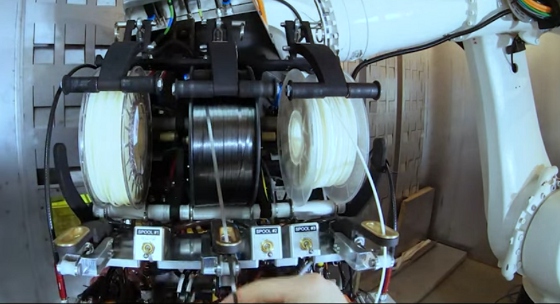
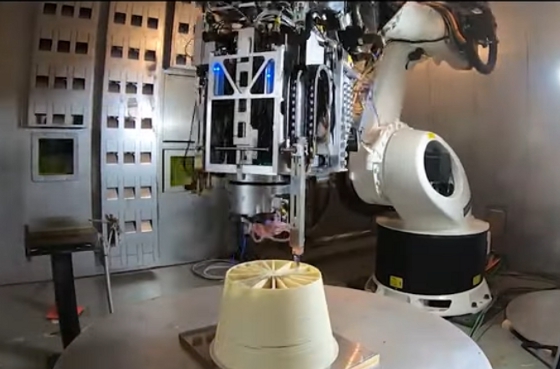
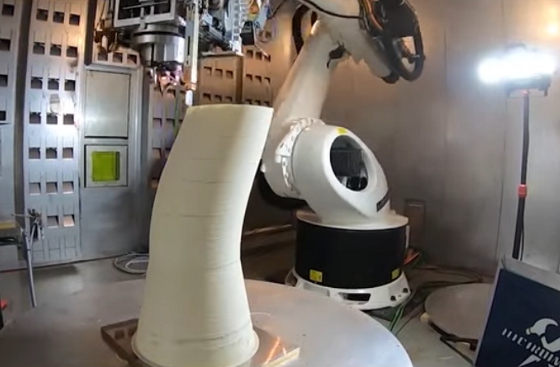
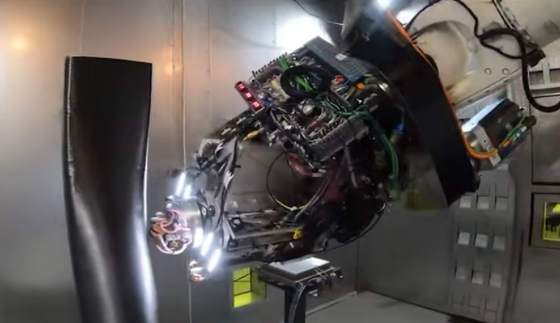
The SCRAM system in action building the composite engine duct. [Credit: Northrop Grumman video screenshots].
3D-printing specialist Markforged provides a very good description of the Continuous Fiber Fabrication (CFF) process (and carbon fiber printing in general, so please check it out). According to Markforged, "The CFF 3D printing process consists of two steps ... first, a thermoplastic is extruded to form the infill and shells of the part -- this serves as the 'matrix' material of the composite. Next, the continuous fiber is ironed into that matrix, fusing with the thermoplastic by use of a compatible resin coating. ... This process is also similar to how rebar can be laid down inside concrete to reinforce it." Although this process may be a little different than Northrop Grumman's SCRAM C/C proprietary process as shown in the video in this article, it gives you a good idea of the basics of integrated materials CFF printing for these types of applications.
Northrop Grumman also recently joined the federal government in implementing AM Forward, a voluntary initiative aimed at strengthening U.S.-based suppliers' adoption and deployment of additive manufacturing (AM) capabilities. AM has the potential to improve the agility of aerospace manufacturers where legacy casting and forging processes are often resource and time intensive; it is a leading-edge production technology that is foundational to U.S. global competitiveness and manufacturing resiliency.
Source: Northrop Grumman
Published June 2023
Rate this article
View our terms of use and privacy policy
